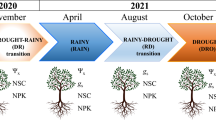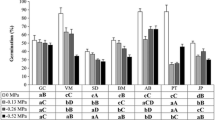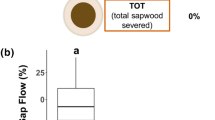Abstract
Drought is known to have an impact on the resistance of conifers to various pests, for example, by affecting resin flow in trees. Little is known, however, about the quantitative and qualitative changes in resin when trees are growing in low moisture conditions. We exposed Scots pine (Pinus sylvestris L.) and Norway spruce (Picea abies (L.) Karst.) seedlings to medium and severe drought stress for two growing seasons and analyzed the monoterpenes and resin acids in the main stem wood after two years of treatment. In addition to secondary chemistry, we measured the level of nutrients in the needles and the growth response of seedlings. After the first year of treatment, drought stress did not affect the growth of seedlings, but in the second year, shoot growth was retarded, especially in Scots pine. In both conifer species, severe drought increased the concentrations of several individual monoterpenes and resin acids. Total monoterpenes and resin acids were 39 and 32% higher in severe drought-treated Scots pine seedlings than in the controls, and 35 and 45% higher in Norway spruce seedlings. In Scots pine needles, the concentrations of nitrogen and phosphorus increased, while magnesium and calcium decreased compared to controls. In Norway spruce needles, nutrient concentrations were not affected. The results suggest that drought stress substantially affects both the growth of conifers and the chemical quality of the wood. We discuss the potential trade-off in growth and defense of small conifer seedlings.
Similar content being viewed by others
References
Allen, S. E. 1989. Chemical Analysis of Ecological Materials, 2nd edn. Blackwell Science, Oxford, p. 368.
Björkman, C. 2000. Interactive effects of host resistance and drought stress on the performance of gall-making aphid living on Norway spruce. Oecologia 123:223–231.
Bryant, J. P., Chapin, F. S., III, and Klein, D. R. 1983. Carbon/nutrient balance of boreal plants in relation to vertebrate herbivory. Oikos 40:357–368.
Christiansen, E. 1992. After-effects of drought did not predispose young Picea abies to infection by the bark beetle-transmitted blue-stain fungus Ophiostoma polonicum. Scand. J. For. Res. 7:557–569.
Christiansen, E., Waring, R. H., and Berryman, A. A. 1987. Resistance of conifers to bark beetle attack: Searching for general relationships. For. Ecol. Manage. 22:89–106.
Cobb, N. S., Mopper, S., Gehring, C. A., Caouette, M., Christensen, K. M., and Whitham, T. G. 1997. Increased moth herbivory associated with environmental stress of pinyon pine at local and regional levels. Oecologia 109:389–397.
Coley, P. D., Bryant, J. P., and Chapin, F. S., III. 1985. Resource availability and plant antiherbivore defense. Science 230:895–899.
Croise, L. and Lieutier, F. 1993. Effects of drought on the induced defence reaction of Scots pine to bark beetle-associated fungi. Ann. Sci. For. 50:91–97.
Croteau, R. and Johnson, M. A. 1985. Biosynthesis of terpenoid wood extractives, pp. 379–439, in T. Higuchi (ed.). Biosynthesis and Biodegradation of Wood Components. Academic Press, London.
Eberhardt, T. L., Han, J. S., Micales, J. A., and Young, R. A. 1994. Decay resistance in conifer seed cones: Role of resin acids as inhibitors of decomposition by white-rot fungi. Holzforschung 48:278–284.
Gilmore, A. R. 1977. Effects of soil moisture stress on monoterpenes in loblolly pine. J. Chem. Ecol. 3:667–676.
Gref, R. and Ericsson, A. 1985. Wound-induced changes of resin acid concentrations in living bark of Scots pine seedlings. Can. J. For. Res. 15:92–96.
Harju, A. M., Kainulainen, P., Venäläinen, M., Tiitta, M., and Viitanen, H. 2002. Differences in resin acid concentration between brown-rot resistant and susceptible Scots pine heartwood. Holzforschung 56:479–486.
Herms, D. A. and Mattson, W. J. 1992. The dilemma of plants: To grow or defend. Q. Rev. Biol. 67:283–335.
Hodges, J. D. and Lorio, P. L., Jr. 1975. Moisture stress and composition of xylem oleoresin in loblolly pine. For. Sci. 21:283–290.
John, K. M. 1970. Colorimetric determination of phosphorus in soil and plant materials with ascorbic acid. Soil. Sci. 109:214–220.
Johnson, R. H., Young, B. L., and Alstad, D. N. 1997. Responses of ponderosa pine growth and volatile terpene concentrations to manipulation of soil, water, and sunlight availability. Can. J. For. Res. 27:1794–1804.
Jones, C. G. and Coleman, J. S. 1991. Plant stress and insect herbivory, toward an integrated perspective, pp. 249–280, in H. A. Mooney, W. E. Winner, E. J. Pell, and E. Chu (Eds.). Response of Plants to Multiple Tresses. Academic Press, San Diego, California.
Kainulainen, P., Oksanen, J., Palomäki, V., Holopainen, J. K., and Holopainen, T. 1992. Effect of drought and waterlogging stress on needle monoterpenes of Picea abies. Can. J. Bot. 70:1613–1616.
Kuusisto, E., Kauppi, L., and Heikinheimo, P. (Eds.). 1996. Climate change and Finland, p. 16, in Summary of the Finnish Research Programme on Climate Change (SILMU). Helsinki University Press, Helsinki.
Larsson, S. and Björkman, C. 1993. Performance of chewing and phloem-feeding insects on stressed trees. Scand. J. For. Res. 8:550–559.
Lindberg, M. and Johansson, M. 1992. Resistance of Picea abies seedlings to infection by Heterobasidion annosum in relation to drought stress. Eur. J. For. Pathol. 22:115–124.
Llusia, J. and Penuelas, J. 1998. Changes in terpene content and emission in potted Mediterranean woody plants under severe drought. Can. J. Bot. 76:1366–1373.
Lombardero, M. J., Ayres, M. P., Lorio, P. L., and Ruel, J. J. 2000. Environmental effects on constitutive and inducible resin defences of Pinus taeda. Ecol. Lett. 3:329–339.
Major, E. J. 1990. Water stress in Sitka spruce and its effect on the green spruce aphid Elatobium abietinum, pp. 85–93, in A. D. Watt, S. R. Leather, M. D. Hunter, and N. A. C. Kidd (Eds.). Population Dynamics of Forest Insects. Intercept, Andover, Hampshire.
Manninen, A.-M., Tarhanen, S., Vuorinen, M., and Kainulainen, P. 2002. Comparing the variation of needle and wood terpenoids in Scots pine provenances. J. Chem. Ecol. 28:211–228.
Mattson, W. J. and Haack, R. A. 1987. The role of drought stress in provoking outbreaks of phytophagous insects, pp. 365–407, in P. Barbosa and J. C. Schultz. (Eds.). Insect Outbreaks. Academic Press, San Diego, California.
Micales, J. A., Han, J. S., Davis, J. L., and Young, R. A. 1994. Chemical composition and fungitoxic activities of Pine cone extractives, pp. 317–332, in G. C. Llewellyn, W. V. Dashek, and C. E. O'Rear (Eds.). Biodeterioration Research 4. Plenum, New York.
Phillips, M. A. and Croteau, R. B. 1999. Resin-based defences in conifers. Trends Plant Sci. 4/5:184–190.
Schulze, E. D. 1991. Water and nutrient interactions with plant water stress, pp. 89–101, in H. A. Mooney, W. E. Winner, E. J. Pell, and E. Chu (Eds.). Response of Plants to Multiple Stresses. Academic Press, San Diego, California.
Temnerud, E. 1999. The occurence of resin pockets in sawlog populations of Picea abies [L.] Karst. from five geographic regions in Sweden. Scand. J. For. Res. 14:143–155.
Teskey, R. O., Bongarten, B. C., Cregg, B. M., Dougherty, P. M., and Hennessey, T. C. 1987. Physiology and genetics of tree growth response to moisture and temperature stress: An examination of the characteristics of loblolly pine (Pinus taeda L.). Tree Physiol. 3:41–61.
Virkkala, R. and Toivonen, H. 1999. Maintaining biological diversity in Finnish forests, p. 56, in The Finnish Environment 278. Edita Helsinki.
Wagner, M. R. 1986. Influence of moisture stress and induced resistance in ponderosa pine, Pinus ponderosa dougl. ex. laws, on the pine sawfly, Neodiprion autumnalis smith. For. Ecol. Manage. 15:43–45.
Author information
Authors and Affiliations
Corresponding author
Rights and permissions
About this article
Cite this article
Turtola, S., Manninen, AM., Rikala, R. et al. Drought Stress Alters the Concentration of Wood Terpenoids in Scots Pine and Norway Spruce Seedlings. J Chem Ecol 29, 1981–1995 (2003). https://doi.org/10.1023/A:1025674116183
Issue Date:
DOI: https://doi.org/10.1023/A:1025674116183




